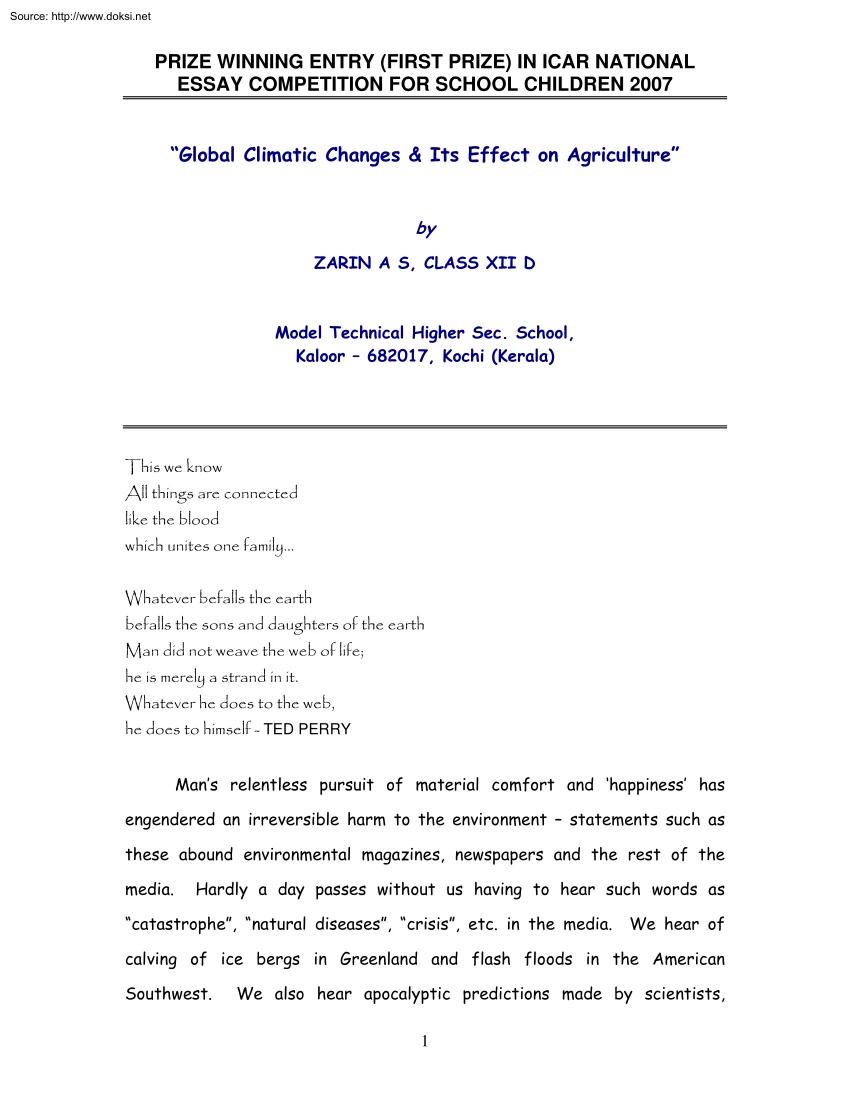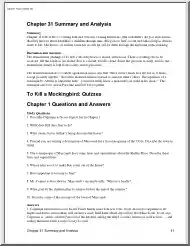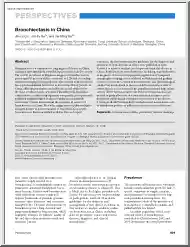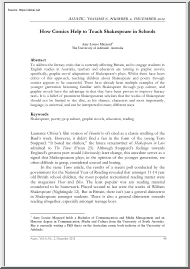Értékelések
Nincs még értékelés. Legyél Te az első!
Mit olvastak a többiek, ha ezzel végeztek?
Tartalmi kivonat
Source: http://www.doksinet PRIZE WINNING ENTRY (FIRST PRIZE) IN ICAR NATIONAL ESSAY COMPETITION FOR SCHOOL CHILDREN 2007 “Global Climatic Changes & Its Effect on Agriculture” by ZARIN A S, CLASS XII D Model Technical Higher Sec. School, Kaloor – 682017, Kochi (Kerala) This we know All things are connected like the blood which unites one family Whatever befalls the earth befalls the sons and daughters of the earth Man did not weave the web of life; he is merely a strand in it. Whatever he does to the web, he does to himself - TED PERRY Man’s relentless pursuit of material comfort and ‘happiness’ has engendered an irreversible harm to the environment – statements such as these abound environmental magazines, newspapers and the rest of the media. Hardly a day passes without us having to hear such words as “catastrophe”, “natural diseases”, “crisis”, etc. in the media We hear of calving of ice bergs in Greenland and flash floods in the American
Southwest. We also hear apocalyptic predictions made by scientists, 1 Source: http://www.doksinet environmentalists and even the laymen about the coastal cities of India getting inundated by the sea. In a country like India where seventy percent of the population is dependent on agriculture, it is imperative that the effect of such drastic changes in environment are studied. Also, it is equally important that we rely more on scientifically proven facts about global climate changes rather than mere conjectures and exaggerations. Effect of Climate Change on Agroiculture – An introduction It is known that climate change is affecting agriculture in many ways. A lot of studies have been carried out by agriculturalists, scientists and economists on the adverse effects of climate change. In India, agriculture and allied activities constitute the single largest component of Grass Domestic Product (GDP) contributing nearly 25% of the total. The tremendous importance of this sector to
the Indian economy can be ganged by the fact that it provides employment to to-thirds of the total workforce. The share of agricultural products in exports is also substantial, with agriculture accounting for 15% of export earnings. Agricultural growth also has a direct impact on poverty eradication, and is an important factor in employment generation. Further, Indian agriculture is fundamentally dependent on weather for higher productivity. The proof of this has been the increasing in agricultural production, owing to good monsoons over the last few years. 2 A few Source: http://www.doksinet conclusions on the effect of climate change on agriculture from different studies are listed below: • Sinha and Swaminathan (1991) – showed that an increase of 20C in temperature could decrease the rice yield by about 0.75 ton/ha (hectares) in the high yield areas; and 0.50C increase in winter temperature would reduce wheat yield by 0.45 tons/ha • Rao and Shina (1994)-showed that
wheat yields could decrease between 28-68% without considering the CO2 fertilization effects. • Agarwal and Sinha (1993) showed that a 20C temperature rise would decrease wheat yields in most places. • Saseendran et al. (2000) showed that for every one degree rise in temperature the decline in rice yield would be about 6%. The above facts emphasize the need to not only study in detail the climate change vulnerability of agriculture but also the methods of improving the adaptive capacity of agriculture to climate variability and extremes. Climate Change Evidence is gathering that human activities are changing the climate. This climate change could have a huge impact on our lives. Here are some grim aspects of climate change. Sea levels are expected to rise by at least 40 cm by 2100, inundating vast areas, including some of the most densely populated cities. What has already happened? Global temperatures has rise by 0.60C in the last 130 years This rise in global temperatures
lead to huge impacts on a wide range of climate related factor. 3 Source: http://www.doksinet Levels of carbon dioxide, methane and nitrous oxide gases are rising, mainly as a result of human activities Carbon dioxide is being dumped in the atmosphere at an alarming rate. Since the industrial revolution, humans have been pumping out huge quantities of carbon dioxide, raising carbon dioxide concentrations by 30%. The burning of fossil fuels is partly responsible for this huge increase. U.S, China, Russia, Japan and India are the leading emitters of carbon dioxide. USA CO2 emissions (in billion tonnes) 5.9 China 4.7 Russia 1.7 Japan 1.3 India 1.1 Country Total world CO2 E mission = 27 bn tonnes, Source: Energy Information Administration, The Guardian Similarly, methane levels in the atmosphere have increased by 145% since the industrial revolution. This increase is a result of gas produced by livestock and paddy fields. The increase in quantity of these gases leads to
what is known as the green house effect. The Green House Effect Under normal circumstances the sun’s rays hit the earth and are reflected back into space. However, gases in the atmosphere such as carbon dioxide and methane form a barrier for sun light. Because of this property of these gases the reflected rays of the sun are trapped in the atmosphere. 4 Source: http://www.doksinet The sun rays cannot escape from the earth’s atmosphere, and the earth heats up. This is called the green house effect Global Warming Global temperatures have risen by 0.50C over the 140 years, since records began. The decade 1990-2000 was the warmest for 300 years and 0.50c warmer than the mean 1961-1990 climate Warm winters have reduced the number of frosts, and the warmer summer has included record hot spells and high sunshine totals. How will Climate Change effect Agriculture? Soil Processes The potential for soils to support agriculture and distribution of land use will be influenced by changes in
soil water balance. • Increase in soil water deficits i.e dry soils become drier, therefore increased need for irrigation but; • Could improve soil workability in wetter regions and diminish poaching and erosion risk Crops The effect of increased temperature and CO2 levels on arable crops will be broadly neutral: • Horticultural crops are more susceptible to changing conditions than arable crops • Field vegetables will be particularly effected by temperature changes • Water deficits will directly affect fruit and vegetable production Grasslands and Livestocks • Poultry and pigs could be exposed to higher incidences of heat stress influencing productivity • Increase in disease transmission by faster growth rates of pathogens in the environment 5 Source: http://www.doksinet Predicted effects of Climate change on agriculture over the next 50 years. CLIMATIC ELEMENT CO2 EXPECTED CHANGE BY 2050 INCREASE FROM CONFIDENCE IN PREDICTION VERY HIGH 360 PPM TO 450-
EFFECT ON AGRICULTURE • GOOD FOR CROPS • INCREASED PHOTOSYNTHESIS 600 PPM SEA LEVEL RISE BY 10-15 CM VERY HIGH RISE • REDUCED WATER USE • LOSS OF LAND • COASTAL EROSION • FLOODING • SALINAZATION OF GROUND WATER TEMPERATURE RISE 1-2OC BY HIGH • EARLIER GROWING INCREASED FREQUENCY FASTER, SHORTER SEASONS OF HEAT WAVES • HEAT STRESS RISK • INCREASED EVAPOTRANSPIRATION PRECIPITATIO SEASONAL LOW N CHANGES BY +- • IMPACTS ON DROUGHT • RISKS SOIL WORKABILITY 10% STORMINESS INCREASED WIND VERY LOW SPEEDS, ESPECIALLY NORTH. IN • WATER LOGGING • LODGING • SOIL EROSION • REDUCED INFILTRATION OF RAINFALL MORE INTENSE RAINFALL EVENTS 6 Source: http://www.doksinet Improving Adaptive Capability of Agriculture The following actions could be helpful in improving the adaptive capability of agriculture: 1. Improved training and general education of populations dependent on agriculture 2. Agricultural
research to develop new crop varieties 3. Identification of the present vulnerabilities of agricultural systems 4. Food programs and other social security programs to provide insurance against supply changes 5. Transportation, distribution and market integration to provide the infrastructure to supply food during crop short falls. In addition to the above improvements, it is imperative that the developed countries and the rapidly developing countries formulate strategies to curb green house gas emissions. Countries on the fast track of economic growth should also look at adopting new energy-saving technologies and planting of more trees. The emphasis should also be laid on increasing the use of renewable energy sources like solar and wind. It is high time for leading emitters of CO2 to formulate national programs to address climate change. Only then the effect of climate change on agriculture can be reduced. 7
Southwest. We also hear apocalyptic predictions made by scientists, 1 Source: http://www.doksinet environmentalists and even the laymen about the coastal cities of India getting inundated by the sea. In a country like India where seventy percent of the population is dependent on agriculture, it is imperative that the effect of such drastic changes in environment are studied. Also, it is equally important that we rely more on scientifically proven facts about global climate changes rather than mere conjectures and exaggerations. Effect of Climate Change on Agroiculture – An introduction It is known that climate change is affecting agriculture in many ways. A lot of studies have been carried out by agriculturalists, scientists and economists on the adverse effects of climate change. In India, agriculture and allied activities constitute the single largest component of Grass Domestic Product (GDP) contributing nearly 25% of the total. The tremendous importance of this sector to
the Indian economy can be ganged by the fact that it provides employment to to-thirds of the total workforce. The share of agricultural products in exports is also substantial, with agriculture accounting for 15% of export earnings. Agricultural growth also has a direct impact on poverty eradication, and is an important factor in employment generation. Further, Indian agriculture is fundamentally dependent on weather for higher productivity. The proof of this has been the increasing in agricultural production, owing to good monsoons over the last few years. 2 A few Source: http://www.doksinet conclusions on the effect of climate change on agriculture from different studies are listed below: • Sinha and Swaminathan (1991) – showed that an increase of 20C in temperature could decrease the rice yield by about 0.75 ton/ha (hectares) in the high yield areas; and 0.50C increase in winter temperature would reduce wheat yield by 0.45 tons/ha • Rao and Shina (1994)-showed that
wheat yields could decrease between 28-68% without considering the CO2 fertilization effects. • Agarwal and Sinha (1993) showed that a 20C temperature rise would decrease wheat yields in most places. • Saseendran et al. (2000) showed that for every one degree rise in temperature the decline in rice yield would be about 6%. The above facts emphasize the need to not only study in detail the climate change vulnerability of agriculture but also the methods of improving the adaptive capacity of agriculture to climate variability and extremes. Climate Change Evidence is gathering that human activities are changing the climate. This climate change could have a huge impact on our lives. Here are some grim aspects of climate change. Sea levels are expected to rise by at least 40 cm by 2100, inundating vast areas, including some of the most densely populated cities. What has already happened? Global temperatures has rise by 0.60C in the last 130 years This rise in global temperatures
lead to huge impacts on a wide range of climate related factor. 3 Source: http://www.doksinet Levels of carbon dioxide, methane and nitrous oxide gases are rising, mainly as a result of human activities Carbon dioxide is being dumped in the atmosphere at an alarming rate. Since the industrial revolution, humans have been pumping out huge quantities of carbon dioxide, raising carbon dioxide concentrations by 30%. The burning of fossil fuels is partly responsible for this huge increase. U.S, China, Russia, Japan and India are the leading emitters of carbon dioxide. USA CO2 emissions (in billion tonnes) 5.9 China 4.7 Russia 1.7 Japan 1.3 India 1.1 Country Total world CO2 E mission = 27 bn tonnes, Source: Energy Information Administration, The Guardian Similarly, methane levels in the atmosphere have increased by 145% since the industrial revolution. This increase is a result of gas produced by livestock and paddy fields. The increase in quantity of these gases leads to
what is known as the green house effect. The Green House Effect Under normal circumstances the sun’s rays hit the earth and are reflected back into space. However, gases in the atmosphere such as carbon dioxide and methane form a barrier for sun light. Because of this property of these gases the reflected rays of the sun are trapped in the atmosphere. 4 Source: http://www.doksinet The sun rays cannot escape from the earth’s atmosphere, and the earth heats up. This is called the green house effect Global Warming Global temperatures have risen by 0.50C over the 140 years, since records began. The decade 1990-2000 was the warmest for 300 years and 0.50c warmer than the mean 1961-1990 climate Warm winters have reduced the number of frosts, and the warmer summer has included record hot spells and high sunshine totals. How will Climate Change effect Agriculture? Soil Processes The potential for soils to support agriculture and distribution of land use will be influenced by changes in
soil water balance. • Increase in soil water deficits i.e dry soils become drier, therefore increased need for irrigation but; • Could improve soil workability in wetter regions and diminish poaching and erosion risk Crops The effect of increased temperature and CO2 levels on arable crops will be broadly neutral: • Horticultural crops are more susceptible to changing conditions than arable crops • Field vegetables will be particularly effected by temperature changes • Water deficits will directly affect fruit and vegetable production Grasslands and Livestocks • Poultry and pigs could be exposed to higher incidences of heat stress influencing productivity • Increase in disease transmission by faster growth rates of pathogens in the environment 5 Source: http://www.doksinet Predicted effects of Climate change on agriculture over the next 50 years. CLIMATIC ELEMENT CO2 EXPECTED CHANGE BY 2050 INCREASE FROM CONFIDENCE IN PREDICTION VERY HIGH 360 PPM TO 450-
EFFECT ON AGRICULTURE • GOOD FOR CROPS • INCREASED PHOTOSYNTHESIS 600 PPM SEA LEVEL RISE BY 10-15 CM VERY HIGH RISE • REDUCED WATER USE • LOSS OF LAND • COASTAL EROSION • FLOODING • SALINAZATION OF GROUND WATER TEMPERATURE RISE 1-2OC BY HIGH • EARLIER GROWING INCREASED FREQUENCY FASTER, SHORTER SEASONS OF HEAT WAVES • HEAT STRESS RISK • INCREASED EVAPOTRANSPIRATION PRECIPITATIO SEASONAL LOW N CHANGES BY +- • IMPACTS ON DROUGHT • RISKS SOIL WORKABILITY 10% STORMINESS INCREASED WIND VERY LOW SPEEDS, ESPECIALLY NORTH. IN • WATER LOGGING • LODGING • SOIL EROSION • REDUCED INFILTRATION OF RAINFALL MORE INTENSE RAINFALL EVENTS 6 Source: http://www.doksinet Improving Adaptive Capability of Agriculture The following actions could be helpful in improving the adaptive capability of agriculture: 1. Improved training and general education of populations dependent on agriculture 2. Agricultural
research to develop new crop varieties 3. Identification of the present vulnerabilities of agricultural systems 4. Food programs and other social security programs to provide insurance against supply changes 5. Transportation, distribution and market integration to provide the infrastructure to supply food during crop short falls. In addition to the above improvements, it is imperative that the developed countries and the rapidly developing countries formulate strategies to curb green house gas emissions. Countries on the fast track of economic growth should also look at adopting new energy-saving technologies and planting of more trees. The emphasis should also be laid on increasing the use of renewable energy sources like solar and wind. It is high time for leading emitters of CO2 to formulate national programs to address climate change. Only then the effect of climate change on agriculture can be reduced. 7




